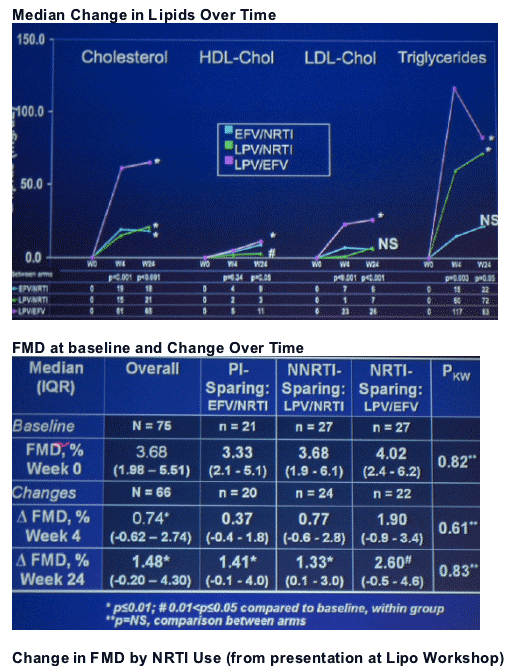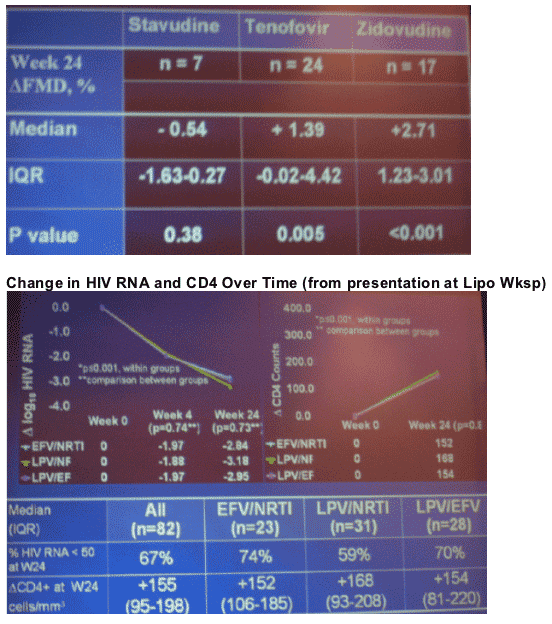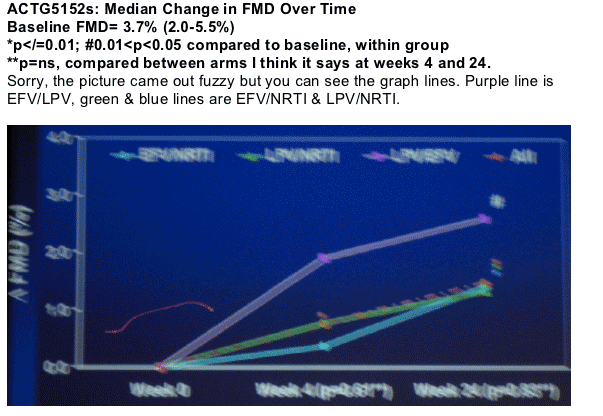 |
 |
 |
| |
Two Trials Find Lower Atherosclerosis Risk With Antiretrovirals
|
| |
| |
4th IAS Conference on HIV Pathogenesis, Treatment, and Prevention
July 22-25, 2007
Sydney, Australia
Mark Mascolini
Twenty-four weeks of highly active antiretroviral therapy (HAART) rapidly improved one marker of heart disease in an AIDS Clinical Trials Group (ACTG) study [1]. And 8 years of therapy lowered rates of another heart disease marker in the US Multicenter AIDS Cohort Study (MACS) [2].
An 82-person substudy of ACTG A5142 found that efavirenz- or lopinavir-based regimens significantly improved endothelial function scores--an early marker of heart disease--regardless of the regimen or its effect on lipids [1]. Instead, the ACTG team correlated improved endothelial function with falling viral load, a result suggesting that better control of HIV explains better endothelial function.
ACTG A5142 researchers randomized antiretroviral-naive people to start efavirenz plus two nucleosides, lopinavir/ritonavir plus two nucleosides, or efavirenz plus lopinavir/ritonavir with no nucleosides. The 82 people in the substudy had a median age of 35 years; 91% were men, 54% white, and 44% active smokers. They entered the trial with a median CD4 count of 245 and a median viral load of 4.82 log copies.
Before this group started antiretrovirals, flow-mediated dilation averaged only 3.68%, far below the normal mark of 8% or higher. Median dilation score improved by 0.74% after 4 weeks of treatment and by 1.48% at week 24 (P < 0.01 for both improvements). Dilation improvement rates did not differ significantly between any two treatment groups. However, while dilation improved significantly among people taking tenofovir (median +1.39%, P = 0.005) or AZT (median +2.71%, P < 0.001), it did not among people taking d4T (-0.54%).
Through 24 weeks total and high-density lipoprotein cholesterol rose significantly in all three treatment arms (P < 0.01), but low-density lipoprotein cholesterol climbed significantly only in the lopinavir/efavirenz arm (P < 0.001), and triglycerides rose significantly only in the two groups taking lopinavir (P < 0.01). In the combined groups viral load fell significantly by 2.1 log at week 4 and 3.0 log at week 24 (P < 0.001). At the end of follow-up, 67% had a viral load under 50 copies. CD4 counts rose by a median 152 cells at week 24 (P < 0.01).
Of all the metabolic and inflammatory markers analyzed, only viral load drop at week 24 correlated with improved flow-mediated dilation (r2 = 0.30, P = 0.02).
MACS investigators measured coronary artery calcification (CAC) as an atherosclerosis marker in three groups--332 gay men without HIV, 84 infected gays who had not taken HAART, and 531 gay men with HAART experience [2]. This cross-sectional analysis excluded men 40 years old or younger and anyone with self-reported or confirmed coronary or cerebrovascular disease. MACS investigators defined calcification as a geometric mean score above 10.
Multivariate analysis determined that older age upped the odds of calcification in all three groups. Compared with HIV-uninfected men of similar age, HIV-infected but untreated men had a 40% higher risk of calcification (odds ratio [OR] 1.42, 95% confidence interval [CI] 0.81 to 2.50), and long-term HAART raised the risk 50% (OR 1.53, 95% CI 1.04 to 2.25). The comparison between HIV-uninfected men and HIV-infected but untreated men lacked statistical significance because the confidence interval crossed 1.0.
In contrast, compared with HIV-uninfected cohort members, men taking HAART for 1 to 7 years had a 31% lower overall calcification score than uninfected men (relative CAC extent 0.69, 95% CI 0.45to 1.07). And men taking HAART for 8 or more years had a 38% lower overall calcification score (relative CAC extent 0.62, 95% CI 0.42 to 0.94). Both of these comparisons were adjusted for age, and the second comparison was statistically significant.
In a subanalysis of 190 men taking HAART for 8 years or more and not taking antilipid drugs, HAART resulted in a 56% lower calcification score (relative CAC extent 0.44, 95% CI 0.26 to 0.76) in an age-adjusted analysis. The same correlation held true in analyses adjusted for age and race, and for age, race, smoking, and family history of coronary heart disease.
References
1. Torriani F, Komarow L, Cotter B, et al. Control of HIV viral replication is associated with rapid improvement in endothelial function sustained over twenty-four weeks: A5152s, a substudy of A5142. 4th IAS Conference on HIV Pathogenesis, Treatment, and Prevention. July 22-25, 2007. Sydney. Abstract WEAB302.
2. Kingsley L, Cuervo J, Munoz A, et al. Subclinical coronary atherosclerosis, HIV-infection and antiretroviral therapy: results from the Multicenter AIDS Cohort Study. 4th IAS Conference on HIV Pathogenesis, Treatment, and Prevention. July 22-25, 2007. Sydney. Abstract TUPEB063.



Study Authors Summarized
No significant change in weight, BMI, insulin, QUICKI, CRP, adiponectin, SICAM, SVCAM, ADMA.
Signigicant increase in glucose at weeks 4 and 24 in EFV arm (p=0.02 and p=0.04).
Significant increase in lipoprotein (a) at weeks 4 and 24 in all arma (p
No consistent correlations between changes in FMD and any variables, other than:
Reduction in HIV RNA at week 24 was associated with FMD improvement at week 24.
Major endothelial dusfunction was identified in subjects with untreated HIV infection.
Endothelial function improved with similar magnitude in all three class-sparing ART regimens, rapidly and in the face of major increases in artherogenic lipid profiles.
There were no strong associations between changes in FMD and metabolic or inflammatory markers, despite major lipid differences between arms.
Improvement in FMD was significantly associated with decreases in HIV RNA at week 24, regardless of baseline HIV RNA and CD4 count.
|
| |
|
 |
 |
|
|